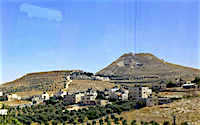The Herodium dominated the landscape south of Jerusalem. It was part fortress and part palace. The walls were built in three concentric rings, with a seven-story tower at each point of the compass. Within the upper complex, there were luxurious living quarters, a Roman theater, a bathhouse, and banquet rooms. There was a large walkway, as well as courtyards that would have been filled with flowers and ornamental plants.
The only access to this upper area was a grand stairway described as having two hundred steps made of the choicest marble. This entrance made the top of the fortress easily defensible while allowing the residents access to the lower complex.
The lower Herodium had a huge pool, with an island in the center. Water was brought in via aqueducts to allow for swimming and the occasional re-enactment of naval battles. The pool was surrounded by elaborate gardens and a horse-racing track. Between the pool and the mountain, there was another palace and a large building that may have served as Herod's tomb.
To the west, there was a small town filled with shepherds and craftsmen. The residents couldn't escape the shadow of Herod's grand palace. If you lived in Bethlehem, you knew the Herodium. It was a constant reminder of the power of the one they called the king of the Jews
But you, Bethlehem Ephrathah, though you are small among the clans of Judah, out of you will come for me one who will be ruler over Israel, whose origins are from of old, from ancient times. (Micah 5:2)
The Herodium lies in ruins today. Herod is long dead and almost forgotten. But the baby that was born in a stable in the little town of Bethlehem is remembered, loved, and worshiped.
Join the discussion about King Jesus on our HopeForLife.org website. Or send your questions to tarcher@heraldoftruth.org.









Comments
Have thoughts on this article? Leave a comment